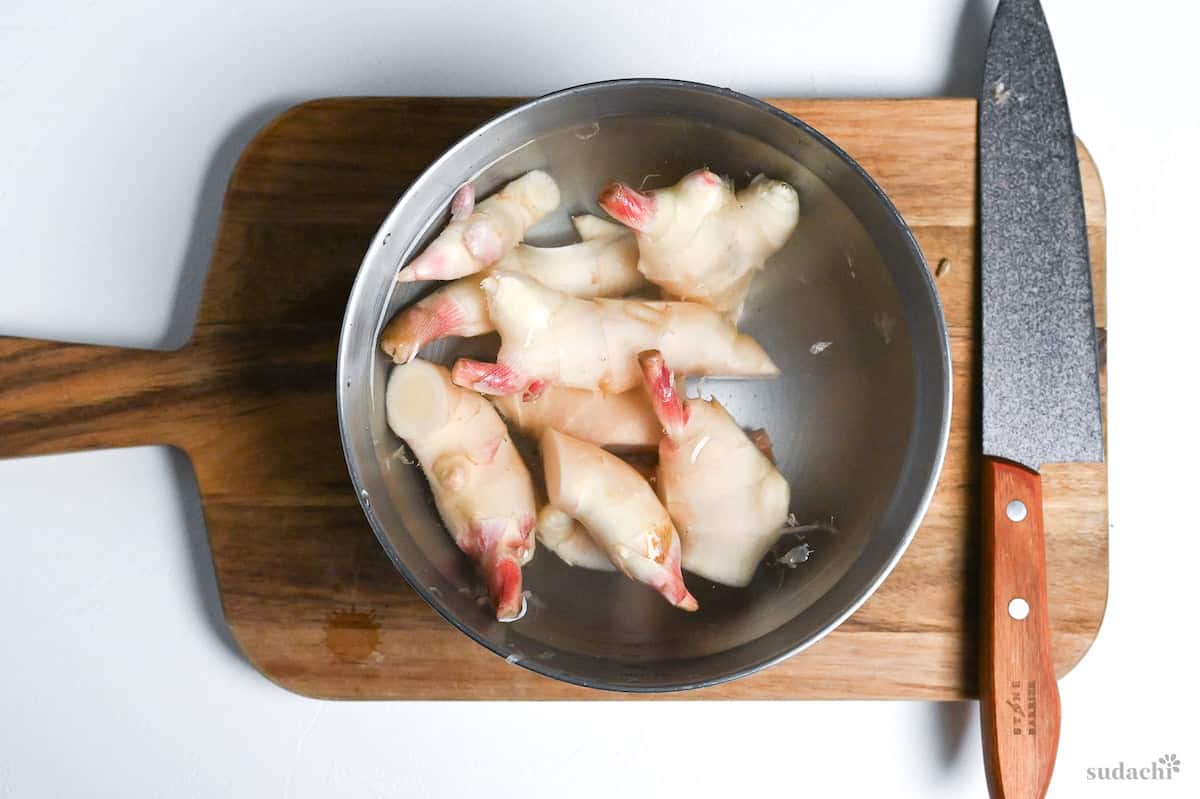Disclaimer: This post may contain Amazon affiliate links. Sudachi earns a small percentage from qualifying purchases at no extra cost to you. See disclaimer for more info.
What is Benishoga?
Benishoga (紅生姜) is a type of Japanese tsukemono made with thin strips of young ginger pickled in a red plum vinegar called “umezu” (梅酢). Umezu is the bi-product of umeboshi, another type of pickle made with a Japanese fruit known as “ume”, which is similar to a apricot or plum.
When the ume are pickled with salt, the juices are drawn out to create white umezu. Salted red perilla leaves (aka shiso/akajiso) are added to the umezu, which turns the liquid into a deep reddish purple, giving the vinegar its iconic color.
People who make umeboshi can use the leftover red umezu to make their own benishoga from scratch. However, red umezu is also readily available at Japanese supermarkets and online, making this recipe more accessible to those outside Japan.
It’s worth noting that store-bought benishoga often has a more reddish-orage color and this is achieved through artificial food coloring. Homemade benishoga has a beautiful and deep pink hue that is achieved naturally through the red plum vinegar.


How I Developed This Recipe
Making benishoga at home is very straightforward, however in some of my previous attempts, the ginger was quite pretty strong and a little overpowering.
To counteract this, I decided to blanch the ginger for a short time to soften the flavor and add a small amount of sugar to the vinegar. These techniques were inspired by my sushi ginger (gari) recipe, which is also seriously good!
Benishoga is bright, bold and the perfect accompaniment for rich, meaty or oily dishes such as yakisoba and gyudon. I seriously recommend this recipe for those who want to add an authentic and refreshing kick to their Japanese meals!
Key Ingredients & Substitution Ideas

- Young Ginger: It is important to note, that benishoga is always made with young ginger (also sometimes known as new ginger or spring ginger) and never the mature ginger that is more readily available. Young ginger is the immature rhizome of the Zingiber officinale and is distinguished by its thin pale skin, pink tips, and bright flavor which is milder than mature ginger.
- Red Ume Plum Vinegar: This bold vinegar is made from the extract juices of salted “ume” plums and colored with red shiso leaves. If you make your own umeboshi, you can absolutely use your own umezu. Otherwise, check your local Japanese supermarket or search online. You can find Eden’s Ume Plum Vinegar on Amazon (affiliate link).
- Salt: I use regular sea salt to help extract excess moisture from the ginger, which helps it better absorb the color and flavor of the vinegar.
- Sugar: I add a small amount of white caster sugar to soften the flavor and add a hint of sweetness. An equal amount of granulated sugar also works just fine.
Curious about the exact brands and products that bring my recipes to life? Discover the brands and ingredients behind my recipes at the Sudachi Amazon Storefront. Explore my handpicked pantry essentials and find your next kitchen favorites!
Jump to Full Recipe Measurements
Visual Walkthrough & Tips
Here are my step-by-step instructions for how to make refreshing benishoga at home. For ingredient quantities and simplified instructions, scroll down for the Printable Recipe Card below.
This section aims to provide a comprehensive overview of the cooking steps and techniques with visuals. It also includes more in-depth tips and tricks and explains why I do what I do.
Take the young ginger and cut off the nodes into manageable pieces about 5cm long. Place them in a bowl of water and gently rub to wash the surface.

Cutting them before washing will allow you to wash them more thoroughly and get into all the crevices.
Drain the water, pat them dry, and cut them into thin slices about 2mm thick.

Young ginger, while milder than mature ginger, still has a strong flavor. If you’re a fan of the intensity, feel free to skip this step. I like to soften the flavor a little by blanching the ginger slices in boiling water for just 1 minute.

After 1 minute, quickly drain through a colander and rinse with cold water to cool.
Squeeze the water out as much as possible.

Transfer to a bowl and sprinkle with salt.

Massage the salt to evenly cover the ginger slices, then cover them with a small clean plate and a heavy object to help squeeze out the excess moisture.

Rest for 1 hour in a cool, dry place.
While it rests, prepare a storage jar. Sterilize by pouring boiling water inside and let it steam for a few minutes. Pour the water out and clean once more with a paper towel and alcohol or a food-safe disinfectant.
After 1 hour, squeeze out the accumulated liquid and discard.

If you have time, lay the slices out on a bamboo tray or similar and leave to dry for several hours in a dry, well-ventilated area.

If you don’t have time, simply dry both sides as much as you can using kitchen paper.

The drier the ginger, the more easily it can absorb the flavor and colors of the red vinegar. If you skip the drying process, you might find your benishoga is uneven.
Finally, it’s time to cut the ginger into its iconic matchstick shape ready for pickling!

Fill your sterilized jar with the julienned ginger. Measure your red ume plum vinegar and mix in a little sugar. Once the sugar has dissolved, pour the vinegar into the jar right up to the top.

Seal with a lid and store in the refrigerator for at least 24 hours before eating. If you have time, I recommend waiting 4-5 days before digging in.

Enjoy!
Jump to Full Recipe MeasurementsHow to Store
Because these pickles are made with 100% vinegar, they have a long shelf life. If the container is properly sterilized before storage, they can last in the fridge for as long as 6 months.
Once opened, I recommend eating them within a few weeks. Check the condition occasionally. If they develop an usual smell or the vinegar turns cloudy then discard.

I hope you enjoy this homemade benishoga recipe! If you try it out, I’d really appreciate it if you could spare a moment to let me know what you thought by giving a review and star rating in the comments below. It’s also helpful to share any adjustments you made to the recipe with our other readers. Thank you!
Try Benishoga with These Recipes!
- Yakisoba (Street Food Style Fried Noodles)
- Takoyaki (Fried Octopus Balls)
- Gyudon (Beef Bowl)
- Sukiyaki Nabe Udon

Japanese Red Pickled Ginger (Homemade Benishoga)
Ingredients
- 100 g young ginger
- ½ tsp salt
- 125 ml red ume plum vinegar
- ½ tbsp sugar
Instructions
- Thoroughly wash 100 g young ginger and roughly cut into 5cm pieces (approx 2 inches). Cut each piece into thin slices about 2mm thick.

- Bring a pot of water to a rolling boil and blanch the ginger for 1 minute.

- Drain the water by pouring the contents of the pan into a colander, then rinse with cold water to cool. Shake thoroughly, then transfer to a bowl and sprinkle with ½ tsp salt. Rub the salt over the ginger until evenly covered.

- Place a clean plate on top of the ginger and weigh it down with something heavy. Rest for 1 hour.

- Squeeze out the accumulated liquid and discard.

- If you have time, arrange the slices on a bamboo tray or mesh sieve and leave to dry in a well ventilated area for several hours. Alternatively, pat the surface dry with kitchen paper.

- Once dried, cut each slice into thin matchsticks and place them in a sterilized, sealable jar.

- Mix 125 ml red ume plum vinegar and ½ tbsp sugar in a jug until the sugar has dissolved. Pour the mixture into the jar, ensuring the ginger is fully submerged.

- Store in the refrigerator and rest for at least 1 day (for best results, wait 4-5 days before consuming). Enjoy!






Leave a rating and a comment